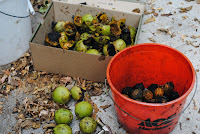Too Far
Buying local; eating local; food miles. These buzz words fall under that politically correct banner that hovers over us before their reality in our future ultimately takes over. Sort of like “green” or “renewable.”
[The other night we went to a newish restaurant which specializes in international beers - I mean, like, 300 varieties. As I sat at the bar facing the solid wall of foreign labels I envisioned every bottle there arriving via an ocean-going vessel. Maybe voyages of 5,000 food miles? Very fossil fuel intensive. And this is so ironic, given the variety of regional local breweries we enjoy.]
 |
| Mulberry Tree |
 |
| Black Walnut Tree |
Apple, Blackberry, Black Raspberry, Black Walnut, Cherry, Chokeberry, Grape, Mulberry, Passionfruit, Peach, Pear, Plum, Quince, Raspberry, Serviceberry, Strawberry
 |
| Cleaning and Sorting Mulberries |
 |
| Ready for Winter |
I have harvested in my own neighborhood over the past two years. Not much foraging, per se, but two trees have been enough to get me started with mulberries and black walnuts. Each source is about .1 food mile away from home! As is common, neighbors who own these trees are grateful to have the fruit cleaned up and off their sidewalks and lawns. (Black walnuts and mulberries can make an unacceptable mess, don’t you know...)
 |
| De-husking Black Walnuts |
 |
| Drying Walnuts |
A little sorting and cleaning and freezing of fruit, and a little bit more labor for walnuts, gets me a store that takes me through winter dormancy!
Knowing Your Place
Local harvesting provides much more than sustenance. Actual foraging reinforces the essential concept of place; the community of nature and people we ought to be intricately acquainted with. It's not just the cluster of houses and yards that streak by while driving. Walking and observing reveals the ecosystem of the neighborhood and, maybe, some personal face time with neighbors themselves! The more we understand the ecology of our place the more likely we are to understand the importance of all sorts of local interactions.
 |
| Ready for Toppings or Baking |
Creating one more natural connection to this sense of place is essential for kids. Imagine the fruit and nuts that could be collected and processed by students from a local neighborhood...
Further Resources:
What I Learned From a Ten Mile Diet - Vicki Robin (exc. TED Talk!)
The Fruit Tree Planting Foundation
